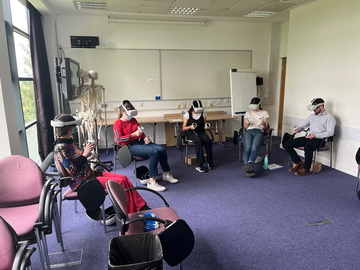The Department of Physiology, Anatomy and Genetics (DPAG) tested a virtual reality (VR) application with third-year medical students to provide them with an immersive experience in understanding anatomical structures and the principles of clinical anatomy.

Students using VR to explore human anatomy. Photo by Xavier Laurent
The VR technology uses Oculus quest2 headsets and the 3D Organon application. Organon is a medical and healthcare education platform for teaching and learning anatomy. The Centre for Teaching and Learning supported clinical anatomist Sharmila Rajendran and her team by providing the headsets and testing the application in advance.
Sharmila and anatomy teaching prosector Samuel Snowdon conducted a preliminary analysis to evaluate the students’ self-exploration experience by collecting feedback from a group of 27 medical students. Based on favourable responses from the students, DPAG sought to broaden the participant pool and introduced the VR anatomy learning opportunity to third-year medical students who had participated in the 3-week Principles of Clinical Anatomy course. Students were encouraged and allowed to self-explore the anatomy application (for different regions of the body) for about 15 minutes each. They were also able to use the ‘multi-user support’ option in the application, which allowed them to join the instructor in an interactive virtual lab session.
"As an anatomist, I believe that a virtual reality platform would break the complex barriers to understanding anatomical structures and brings student's Anatomy learning even closer. We recently used virtual anatomy software using the oculus quest headset with help from the centre for teaching and learning, University of Oxford, to provide a virtual experience to the graduate entry medical students. Students responded that the session was engaging and exciting and desired to have more VR sessions in the future labs. A combination of innovative tools and the traditional methods is a promising way of teaching that would be highly beneficial for the students learning." Sharmila Rajendran
A total of 65 medical students provided their feedback about their VR learning experience. Their feedback was very positive. For example, when they were asked if they think VR sessions should be part of the future curriculum, the majority of participants responded yes.
The Centre for Teaching and Learning continues to provide support and advice to adopt best practices and associated pedagogies when working with these new tools.
"I think that the VR sessions have been a really enjoyable and helpful way to learn anatomy. It’s very helpful being able to see all the structures in 3D and figure out how different parts connect and fit together. The demonstrators have also been very helpful and clear when explaining how to use the devices." Student, Department of Physiology, Anatomy and Genetics